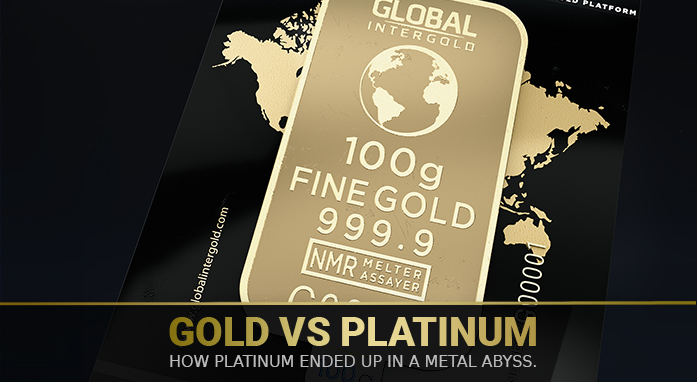Summer’s Must-Read: gold outperforms platinum

Gold and platinum are valuable metals that are in the great demand and have long competed in terms of price.
However, if gold demonstrates constant stability and growth in the long-term perspective, the price of platinum changes quite abruptly. Recently, the price of platinum has reached its lowest value, thus the white metal costs one and a half times less than usual.
How did the pricing policy evolve over the past decades and what are the future prospects?
Platinum and gold in brief
Platinum is a noble metal of silver-white color, which gained prominence in the Old World thanks to the Spanish conquistadors. They brought it from South America to Europe in the middle of the XVI century.
Most platinum deposits are located in South Africa, America, Russia, Zimbabwe and China.
Field of application of platinum (chart):

The automotive industry ranks first in terms of platinum consumption, jewellery ranks second, and the industrial area is in third place.
Gold is a noble yellow metal contained in the ores and rocks of the Earth. Humanity discovered gold in the V millennium BC.
Deposits of the precious metal: China, Russia, Australia, USA, Peru, South Africa, Canada, Mexico, Ghana, Indonesia.
The main areas of gold consumption (chart):

The jewelry industry occupies the leading position in terms of gold demand. The production of coins and gold investment bars ranks second. The third place: central banks that buy the noble metal to replenish national reserves.
Platinum rate fluctuations
Over the past forty years, the price of white metal has experienced significant ups and downs, demonstrating strong volatility.
In the 1970s, an ounce of platinum was estimated at an average of $152.
By the mid-80s, the metal had risen in price, reaching $280.
In the 1990s - nearly $395.
Over seventeen years, platinum rose to $1,530, but by the end of 2008 the situation had changed dramatically due to a price collapse — $900.
2015 was the toughest year for platinum, when the ecological scandal on the dangers of cars with diesel engines broke out, resulting in a large surplus of unsold platinum, which led to a decrease in the price of an ounce of platinum to $873.
In 2018, the platinum rate dropped to $802 per ounce.
Over the past five years, platinum has significantly decreased in price, and has so far failed to reach the same high level.
The graph shows the devaluation of platinum in 2014-2019:.

On July 29, 2019, the price of white metal was $871 per ounce.
The price rally* of gold
Until 1976, there was a fixed price for the yellow metal — $35 per troy ounce. Then a floating exchange rate* system was introduced, marking the beginning of an active increase in the price of gold. By 1995, it had increased eightfold — $387.
From 2000 to 2007, gold rose in price to $834, and over the next few years, its price increased by almost 70% — in 2010, the gold rate reached $1,405.
In 2018, the yellow metal showed a rapid growth rate, rising by 15%.
Globally, production volumes increased significantly, and the central banks of various countries broke the fifty-year record of precious raw materials’ procurement. There was a significant strengthening of the position of gold as the most popular and promising asset. In the first quarter of 2019, the gold demand increased by 7%.
Over the past six years, the yellow metal has been at its peak. The price of an ounce of gold is constantly increasing, proving the stability and reliability of the metal.
The dynamics of the gold rate in 2018-2019 (graph):

Why are the prospects of gold so high?
A high dynamic of the yellow metal rate is the most important factor indicating the real state of the global economy. Gold is a safe haven in the event of a global crisis.
The ratio of gold and platinum for the last five years (graph):

Gold deservedly occupies a leading position in the market of precious metals. The yellow metal is the most liquid and promising asset, it is trusted by the world's leading powers, experienced investors and financial market experts.
CONCLUSION:
-
Gold gets more expensive in the long run;
-
The demand for the yellow metal is growing steadily;
-
The gold market is transparent;
-
Gold is a low-risk investment that provides reliable protection of personal savings;
-
Gold is the best tool to accumulate your savings.
Experts are certain about the great prospects of gold, forecasting a further increase in its price.
On July 29, 2019, the price of an ounce of gold was $1,419.
WILL THE GOLD STANDARD RETURN?
Glossary:
*The price rally of gold — the upward price trend of the precious raw material.
*A floating exchange rate — the international system with non-fixed exchange rates determined by the market and not by the state.

![[VIDEO] Young investors choose gold
[VIDEO] Young investors choose gold](https://f01.gig-os.com/74/2c/cc/2b/74/742ccc2b74d465054d6aed797b9de6a1_5.jpg?1)
![[VIDEO] The US legalizes payments in gold [VIDEO] The US legalizes payments in gold](https://f01.gig-os.com/cf/b1/ba/70/55/cfb1ba7055dd2524218f5aabd01efea8_5.webp?1)
![[VIDEO] Record gold demand: market situation in Q1 2025
[VIDEO] Record gold demand: market situation in Q1 2025](https://f01.gig-os.com/0d/85/47/0b/15/0d85470b15a79bc2aabf122c0d401060_5.webp?1)
![[VIDEO] Investors in Asia are buying up gold!
[VIDEO] Investors in Asia are buying up gold!](https://f01.gig-os.com/45/45/84/6f/73/4545846f738945417567ffd2f6f163bb_5.webp?1)
![[VIDEO] Gold price has increased 9 times since the early 2000s!
[VIDEO] Gold price has increased 9 times since the early 2000s!](https://f01.gig-os.com/47/af/07/eb/bb/47af07ebbb01542f14c0aae36a81f1c0_5.webp?1)
![[VIDEO] The US is urgently increasing gold mining — what’s going on? [VIDEO] The US is urgently increasing gold mining — what’s going on?](https://f01.gig-os.com/43/06/89/4d/da/4306894dda97c98b6e595409af58b694_5.webp?1)
![[VIDEO] China sets trends in the global gold market
[VIDEO] China sets trends in the global gold market](https://f01.gig-os.com/5b/81/78/92/92/5b81789292d5e49f20ca7ca093a27cbe_5.jpg?1)
![[VIDEO] Central banks acquired a quarter of the world's gold!
[VIDEO] Central banks acquired a quarter of the world's gold!](https://f01.gig-os.com/81/2d/76/ff/b0/812d76ffb00ee75856059a67a872642c_5.webp?1)
![[VIDEO] Gold: new records amid market volatility
[VIDEO] Gold: new records amid market volatility](https://f01.gig-os.com/03/8b/98/61/b7/038b9861b74be1ae5d57e56e2d2dc859_5.webp?1)
![[VIDEO] Depreciation of money: how to preserve capital? [VIDEO] Depreciation of money: how to preserve capital?](https://f01.gig-os.com/f9/05/87/f3/5d/f90587f35d2d7a1df8880c220372ab8b_5.webp?1)